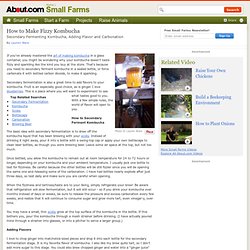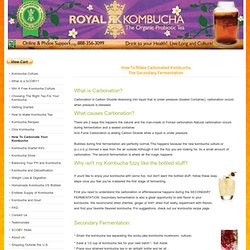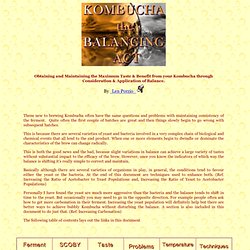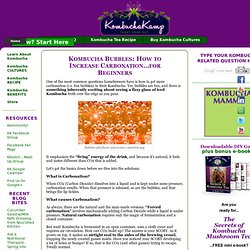

How to Make Fizzy Kombucha - Secondary Stage Fermenting. If you've already mastered the art of making kombucha in a glass container, you might be wondering why your kombucha doesn't taste fizzy and sparkling like the kind you buy at the store.

That's because you need to secondary ferment kombucha in a sealed bottle, or force carbonate it with bottled carbon dioxide, to make it sparkling. Nourishing Cultures. What is Kombucha?

Kombucha is an ancient and truly delicious tangy-sweet beverage that has many health benefits and has been passed down from generation to generation. It is the result of a fermentation process combining a Kombucha Mushroom, or 'Scoby' (Symbiotic Culture of Bacteria and Yeast) tea, sugar and water. Authentic kombucha scoby's are self-propagating making it a wonderful sustainable, enjoyable and economical beverage to do at home.
How To Carbonate Your Kombucha. What is Carbonation?

Carbonation is Carbon Dioxide dissolving into liquid that is under pressure (Sealed Container), carbonation occurs when pressure is released. What causes Carbonation? There are 2 ways this happens the natural and the man-made or Forced carbonation.Natural carbonation occurs during fermentation and a sealed container.And Force Carbonation is adding Carbon Dioxide while a liquid is under pressure. Bubbles during first fermentation are perfectly normal,This happens because the new kombucha culture or (s.c.o.b.y) formed a seal from the air outside.Although it isnt the fizz you are looking for, its a small amount of carbonation. The second fermentation is where all the magic happens.
Why isn't my Kombucha fizzy like the bottled stuff? If you'd like to enjoy your kombucha with some fizz, but don't want the bottled stuff, follow these easy steps once you feel you've mastered the first stage of fermenting. Secondary Fermentation: Do you REALLY want to increase carbon... - Kombucha Tea - tribe.net. Although some types of yeast tend to produce more alcohol than others, (and subsequently less CO2), carbonation is more so a product of the activity of the culture.

CO2 production continues throughout the fermentation as yeasts go through growth and reproduction. Typically more CO2 is produced by individual yeast prior to reproduction and when the greatest amount of oxygen is available. But an active culture will have yeast at various stages. Also the presence of oxygen becomes less of a factor when there is a dearth of available glucose.
That said the best ways to increase carbonation are as follows: 1) Use the two stage bottling technique outlined below. Two Stage Bottling fails to produce the desired results. 2) When you make your next batch use starter from the bottom of the last fermented batch. Kombucha, The Balancing Act. I currently use a two stage bottling technique to finish off my KT fermentation.

This method is fairly easy and allows for tweaking the end product along the way to adjust for variation in the fermentation results. In stage one, plastic bottles are used to store the ferment to allow carbonation to build up, typically over a couple of days following harvest of the ferment. In stage two, I use glass bottles with plastic lids, which is how I store KT until I'm ready to drink it. Any size bottles can be used. I prefer 600 ml plastic and 300 ml glass soda bottles. Here is the procedure: 1. It's best if the ferment is filtered in one pass for consistent results. Note: I still filter half at a time but now I do so on purpose. Kombucha Carbonation Tips – Part 1. One of the most common questions homebrewers have is how to get more carbonation (i.e. fun bubbles) in their Kombucha.

Yes, bubbles are fun, and there is something inherently exciting about seeing a fizzy glass of iced Kombucha froth over the edge as you pour. Bubbles add flavor and texture, scientists say. It emphasizes the “living” energy of the drink, and because it’s natural, it feels and tastes different than CO2 that is added. Let’s get the basics down before we dive into the solutions: What is Carbonation? When CO2 (Carbon Dioxide) dissolves into a liquid and is kept under some pressure, carbonation results. How to Increase Kombucha Carbonation…For Advanced Brewers. This post is a follow up to Kombucha Bubbles: How to Increase Carbonation…for Beginners.

If you are looking to increase your fizz factor while brewing Kombucha, try those techniques first and if you are still unable to achieve the carbonation you are looking for, only then try those listed below. These methods are intended for the more experienced Kombucha brewer and even then only for those who have extra cultures to experiment with. I recommend using one method at a time to see how it works and avoid over yeasting your brew. First though, to understand what we want to accomplish, let’s take the opportunity to more deeply explore the yeast/bacteria symbiotic relationship! The bacteria and yeast in the starter culture work in symbiosis to transform tea and sugar into fermented Kombucha tea.
The balance between the yeast and bacteria can be a delicate one. Symptoms of an unbalanced Kombucha brew that may need a yeast boost: What is Yeast? DID YOU KNOW? Take Starter Liquid From the Bottom.